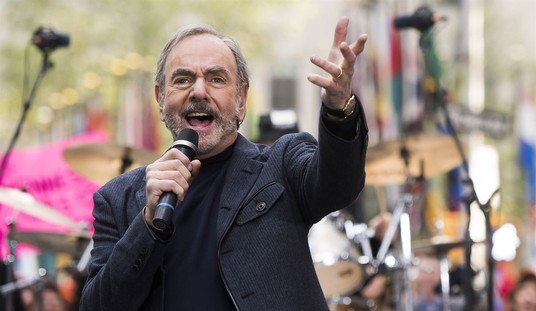Could Donald Trump’s bout with COVID-19 be over — or are there other priorities in play here? Chief of staff Mark Meadows told Fox News this morning that they’re “optimistic” that Trump could make it back to the White House by this afternoon, thanks to his “unbelievable progress.” The Associated Press reported the same thing earlier in the morning:
Watch: WH Chief of Staff Mark Meadows says @realDonaldTrump is making “unbelievable progress” and is “ready to get back to a normal work schedule,” adding that doctors will reevaluate and make a decision to discharge him later today pic.twitter.com/FubqUcCxVY
— TV News HQ (@TVNewsHQ) October 5, 2020
President Donald Trump was hoping for a Monday discharge from the military hospital where he is being treated for COVID-19, a day after he briefly ventured out while contagious to salute cheering supporters by motorcade in a move that disregarded precautions meant to contain the deadly virus that has killed more than 209,000 Americans.
White House officials said Trump was anxious to be released after three nights at Walter Reed National Military Medical Center, where doctors revealed on Sunday that his blood oxygen level dropped suddenly twice in recent days and that they gave him a steroid typically only recommended for the very sick. Still, the doctors said Trump’s health is improving and volunteered that he could be discharged as early as Monday to continue the remainder of his treatment at the White House.
“This is an important day as the president continues to improve and is ready to get back to a normal work schedule,” White House chief of staff Mark Meadows told Fox News on Monday. He said the determination on whether Trump would leave the hospital won’t be made until later in the day after the president is evaluated by his medical team, but that Trump was “optimistic” he could be released Monday.
Less than one month until Election Day, Trump was eager to project strength despite his illness. The still-infectious president surprised supporters who had gathered outside the hospital, driving by in a black SUV with the windows rolled up. Secret Service agents inside the vehicle could be seen in masks and other protective gear.
The optic benefits of a discharge are obvious, but … what’s the rush? According to the president’s doctors, Trump was symptomatic enough to necessitate a hospitalization on Friday. Walter Reed has a presidential suite in place with all of the tools Trump needs to conduct business in comfort, if not in style. And since he’ll have to quarantine anyway, why not relax at the Bethesda White House for a few more days, where doctors can keep a close eye on him, especially with a disease that’s known to be tough to shake off on the first pass?
To be fair, though, there are reasons for an American president to project strength outside of the obvious political considerations, in or out of an election year. An incapacitated president invites all sorts of mischief from our enemies, and it unsettles investors and allies in ways that can cost jobs and damage our short-term economic prospects. If Trump can safely be released and avoid that, that’s beneficial in a wider sense than just for his ego.
Speaking of safety, the drive-by turned out to be a lot less problematic than yesterday’s handwringing supposed, at least to a former White House physician. Dr. William Lang told CNN yesterday that the added risk was “tiny,” and that Trump appears to be doing a lot better than people suppose:
Former White House physician Dr. William Lang: Trump’s short drive outside the hospital produced only a “very, very small” risk to the Secret Service agents. Trump “sounded very strong.” pic.twitter.com/96JdEKqMSC
— Ian Miles Cheong (@stillgray) October 5, 2020
CABRERA: Joining us now CNN Political Correspondent Abby Phillip and former White House Physician William Lang. Dr. Lang, I want to ask you about the drive-by. Did the president needlessly put the Secret Service officers at risk for this photo-op?
DR. WILLIAM LANG, FORMER WHITE HOUSE PHYSICIAN: Well, everything you do has risks and benefits. He wore a mask, the Secret Service agents who a mask, most likely N95 masks. By all of them wearing N95 masks, you couldn’t tell exactly from the pictures but that’s what you would expect to happen. That makes the risk actually very, very small. Is there an increased risk? Maybe tiny. But they took measures to reduce the risk and that’s what it’s all about, is risk management, risk reduction.
CABRERA: You’ve got to also wonder about the president’s health and whether this was in his best interest. The president says in this video that it’s been an interesting journey, almost like it’s over. Doctor, based on what we learned from his medical team today about his oxygen saturation levels having dropped at least a couple of times below 94 percent saturation, and also the fact that he needed supplemental oxygen, that he had a high fever on Friday, the fact that he’s on some very serious treatments, including an experimental treatment that hasn’t even been cleared for emergency operation use, the fact that he’s had remdesivir and continue those treatments.
He’s had two and we’re expecting a five-day treatment, according to his doctor. The fact that he’s now on this steroid that’s only given to the most severely ill, is the president in the clear at this point?
LANG: Well, the fact is that he is the president of the United States. And, of course, they are going to throw everything at him to get him as well as they can as fast as they can. He has never been significantly symptomatic. One of the things that I find very interesting is when you talk to a patient who has any kind of respiratory illness, one of the first things you do is listen to them. You listen to the way they talk. When you listen to his tone, his ability to talk in complete sentences, how he sounded in the release just a few minutes ago, he sounded very strong.
So that tends to — that gives you a very, very good indication that he does not have significant, active respiratory disease. And throughout this, the only real complaint that the president has had has been the fever. Even when his oxygen saturation dropped below 94 percent, as Dr. Conley noted on Friday, which was the reason that they — one of the main reasons why they decided they wanted to bring him to Walter Reed to watch more carefully, and then, again yesterday, he was never symptomatic.
So that, as many docs will say, we’re finding with a lot of the COVID- 19 patients, they don’t get too symptomatic. But, still, he appears to be feeling pretty good. He sounded very good in that last release that we had. So he does seem to be on the mend. Now, can that change? Sure. And that’s the reason why it’s very, very important to maintain a close watch over where he stands.
Still, the “big deal” is that it’s an unnecessary addition of risk, even if it is “tiny,” as Dr. Lang says. The same is true of an expedited release. If Trump can do the job from Walter Reed, it seems like a no-brainer to stick around there for a couple of more days until doctors can be confident that the acute stage of the disease has passed. That will leave the president plenty of time to make more campaign appearances via Zoom, and videos for his re-election efforts, which will be all he’ll be able to do for a while anyway.








Join the conversation as a VIP Member